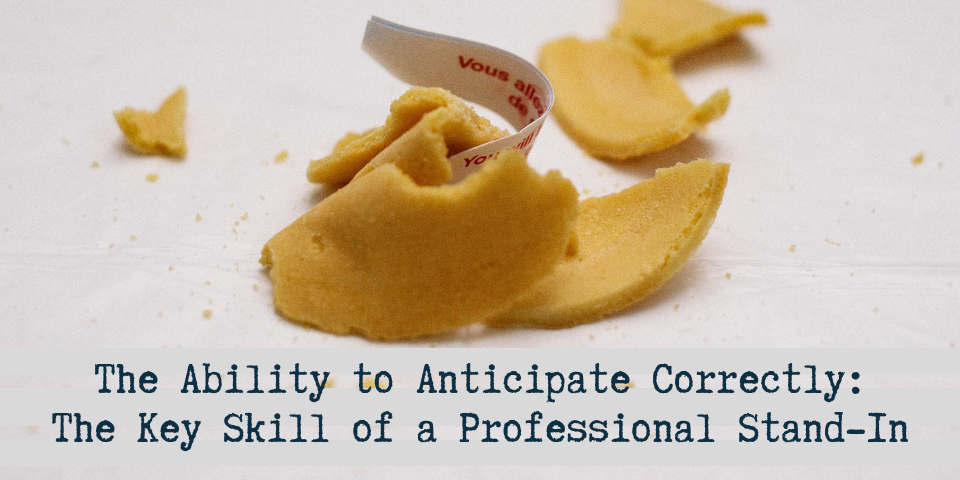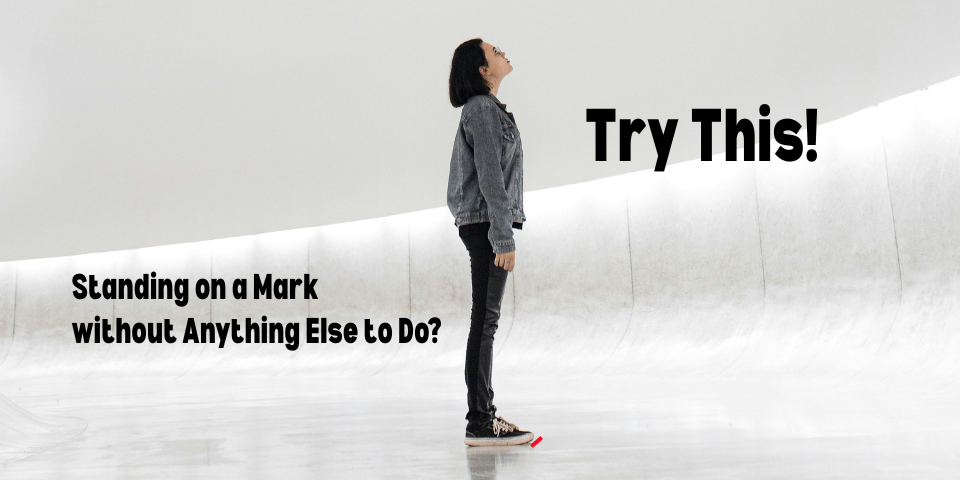Human beings can’t read minds or predict the future.
However, great stand-ins can approach those superhuman abilities if they really learn their job and really care about doing it well.
In other words, while stand-ins might not be able to read minds or predict the future, they can develop their skills so well to regularly and correctly anticipate when they are needed.
Are you interested in cultivating that skill? Here are some tips I’ve developed to help me correctly anticipate when I’m needed time and again — and lock in more and more stand-in work as a result of this valuable yet subconscious skill.
Think of Yourself as a Tool
When I really want to exceed at a stand-in job, I think of myself as a tool.
I then ask myself, “Whose tool am I right now?”
If the DP is the central person on set at the moment, figuring out the shot, I think of myself as the DP’s tool. If the DP is working with the director and the director is setting up the shot, I’m the director’s tool. If the camera department is working with me, I’m the camera operator’s tool.
Whoever is doing something that might in the moment involve the stand-ins, I’m their tool.
Track the Important Crew Person
Keeping in mind that I’m a tool, as a tool, I don’t want to be far away from the important crew person on set.
Oftentimes, it’s the DP I track the closest when I’m standing in. When the DP is talking with the director or the gaffer, not far in the periphery. I’m there, paying slight attention to the conversation or body language of the DP to see if there might be a sudden or looming need for a stand-in.
If there is, then I’m just a few steps away. If they call for second team, by the time they finish saying the phrase, “Second team!,” I’m basically standing right there. As if, POOF!, I emerged at a moment’s notice.
When the other stand-ins are scurrying in from the nether regions of the studio, blurry-eyed and not knowing what is needed, I’m already ahead of the game, there and knowing why I’m needed.
What carpenter wants his or her hammer far away? A carpenter wants his or her tools close. The same with stand-ins.
But not too close! Just close enough. As if I’m not there, or as if I’m not paying attention. But I am.
Learn the Rhythms of This Particular Set
When you’re new to a set, your stand-in skills are taxed as you’re trying to figure out how they do things here. Do they call for second team? Do they want you to do lines? Are they mean or nice? Do they use you at all, or do they really lean on you when setting up a shot?
But when you figure out some of those answers, and you start to learn some of the rhythms and patterns on this particular set, you not only can start to anticipate when you’ll be needed, but your awareness can also heighten when those rhythms or patterns change.
And when those rhythms or patterns change, no one might have called for second team, but you have a spidey sense there might be a need for you, and you might start moving closer to set to investigate whether they might call for you.
And if they do call for you, because you’re familiar with the rhythms and patterns of this set and when there are deviations, you’ll be close by rather than far away at crafty. And you will be highly appreciated for being so in tune with your job and the jobs of those people who need you, when they need you.
Understand the Needs of Important Crew People
When you learn deeply what each kind of crew person cares about, when you are standing in you can better know how to quickly serve and satisfy their needs.
DPs want to light you, so they are aiming lights at your face. They want to see your face, they want to know if your actor is wearing glasses or wearing the same color you are wearing. They want to know if your actor is wearing her hair over her ears or not. When you know these questions DPs frequently have, you can have the answers at the ready, rather than being stumped and stunned when asked the question. Anticipating the kinds of questions a DP might have lends to seeking their answers and being able to answer them swiftly — impressively.
Camera operators want to rehearse shots. They want marks on the ground where you stand, and they want you re-marked on the ground if they move you to a different place. They want to know if your actor turned clockwise or counterclockwise, how close or how far the actor went in the scene, whether she leaned forward at all, whether she ever looked at another actor in the scene. Knowing those answers, you demonstrate a tremendous amount of added value as a stand-in to a camera operator.
Boom operators might want to know on what lines your actor moved. Gaffers might want you to stand on a mark as a light is aimed at you. Second 2nd ADs might want you to tell them where you are going if you are leaving the set, going to the bathroom, or going to crafty. People in the props department might not want you to touch props. Set decorators might be okay with your moving your chair — or not.
When you understand the needs of important crew people, they don’t lose energy telling you what they are. You just know them — and can anticipate them, in order to satisfy them.
Pay Attention
If you don’t know what’s going on, you’ll be stunned when things change. But if you know what’s going on, you can anticipate the next thing, the next thing, and the next thing. And before they happen, you can prepare for those next things.
All in all, in order to anticipate correctly over and over again, pay attention.
Read the callsheet. Read more than just what your calltime is, or where your pickup is. Note the days the scene is — D1, D2, N1, N2, etc. — and familiarize yourself with what your actor wore or how he or she looked in scenes on those days. (You can use that information to wear appropriate color cover, shoes, and hair styles that day for the work to be shot.)
Listen to private discussions, rumors, gossip. Little pitchers have big ears: Many people might not think you are listening because you are the minor position of the stand-in, but because of that, you can pick up important information regarding the planning of the day, the next day, or the rest of the shoot. Of course, always asterisk that information in your mind, given that you might not know the whole story around what you were hearing, and rumors and gossip may be just that rather than important production information.
Follow directions. Avoid distractions like smartphones and conversations with other stand-ins, unless you are able to do these in ways that do not compromise your function as a tool and your usefulness. If you’re looking down in your phone while a DP is lighting you, you might be there — but you’re not useful.
In the End
Caring about your work as a stand-in might lead you to any of the above skills and ways of thinking that help you anticipate correctly when you are needed as a stand-in. (You might well have also bought The Stand-In Handbook as another show of your care for the job of the stand-in and being as professional as you can be.)
If you don’t care about your work, you probably won’t achieve these levels of sophistication in your work. And that might mean why you don’t work as much, differentiate yourself as a stand-in, or have people asking for you.
Your choice!
Do you have any other tips for anticipating correctly when you are needed on set? Share your advice in the comments below!







Leave A Comment